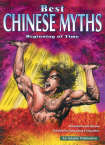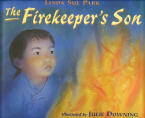|
The AACP Newsletter |
||
| Since 1970 | Asian American Curriculum Project, Inc. - Books for All Ages | August 2004 |
| Newsletter Home Page | Event Schedule | AsianAmericanBooks.com | Editor's Notes | Featured Books |
At a GlanceAsian Americans in HollywoodA movie review of "Harold and Kumar go to White Castle"
Asian American Image in Books
|
|
||||
|
An Open Email Discussion by Leonard Chan, Philip Chin, and Michael Kim |
|
|
The following are excerpts from emails that were sent between our newsletter staff over the debate of whether we should include "The Golden Mountain" in our newsletter. I posed the following questions to our group -
Leonard From what I can gather, the story is a semi-fictionalized account of the life of the author's great grandmother, grandmother, mother, and her own. Like many stories that get published, this book seems to paint late 19th and early 20th century Chinese society as misogynistic. Further, the first 20 pages contains a scene where a father kills his new born daughter for being a girl and also seems to portray China Chinese as avid practitioners of bigamy (not the wife in two countries case). First of all, this could be true, but should we be advocating such a negative story on Chinese society? Would I be white washing Chinese society and culture by not featuring this book? If this was typical for Chinese society, shouldn't we have no apprehensions about advocating such a well written book? Could any of you tell me that this negative imagery was not true for the majority of Chinese society?
Philip
Michael I think, with any publication, you want something that's completely honest about what it is. If the contents are fiction, you want that to be apparent. If it's not a fair depiction about a certain time or culture, the readers should know that. Ironically, some of my Asian American Studies lecturers said that authors like Kingston have no obligation to represent Asian cultures accurately and can write whatever they want. Even though I think they said that mostly in a spirit of anti-censorship and support for Asian American authors, I don't agree at all. With so many stereotypes and misconceptions about Asian Americans and Asian cultures, I think any author |
who writes about Asian and Asian American issues should give a full and accurate portrayal of them. Why is there so much focus on China at the turn of the twentieth century? Why do authors feel the need to associate misogyny with China and Asian cultures when there's arguably as much in other cultures? These are questions that need to be asked. I think if you do include this book, you should include others (possibly nonfiction) with different perspectives so that you're not advocating an inaccurate portrayal of Chinese culture as a one-dimensional misogynist culture.
Philip Imagine what slavery would look like in the history books if only the descendants of slave masters wrote the stories about what it was like. Slavery would look like a very benign and good system I would think. From the modern woman's perspective, Chinese society of that time was misogynist. As for it being one dimensional, that is probably the function of the leisured classes being the ones telling the story. How many stories in English tell about life from an ordinary Chinese peasant perspective with all of its complications? I think only Pearl Buck's "The Good Earth" fits that bill and she was white and writing in the 1930s. Has anything happened in popular "Asian" literature since then, except for Tan and Kingston? Perhaps part of the problem is that Asian men haven't written hit stories that would combat the perception that we are all misogynists.
Leonard It's now your turn - buy "The Golden Mountain" or check it out from a library. Give us your feedback. Thanks. |
The following books are discounted for subscribers to our newsletter. The discounts on these books end September 15, 2004. | |

|
Good-bye 382 Shin Dang DongBy Frances Park and Ginger ParkIllustrated by Yangsook Choi 2002, 29 pages, hardback. Jangmi finds it hard to say goodbye to relatives and friends, plus the food, customs, and beautiful things of her home in Korea, when her family moves to America.
View Additional Information
|

|
Best Chinese Myths
Translated by Gong Lizeng and Yang Aiwen |

|
The Firekeeper's SonBy Linda Sue ParkIllustrated by Julie Downing 2004, 37 pages, hardback. In early-19th-century Korea, after Sang-hee's father injures his ankle, Sang-hee attempts to take over the task of lighting the evening fire, which signals to the palace that all is well. Includes historical notes.
View Additional Information
|

|
Chinese Astrology
By Sherman Tai |

|
The Golden Mountain
By Irene Kai |
Copyright © 2004 by Asian American Curriculum Project, Inc. (a non-profit organization since 1970)
Visit our website at AsianAmericanBooks.com
To unsubscribe simply reply to this email and type "REMOVE" in the subject line.